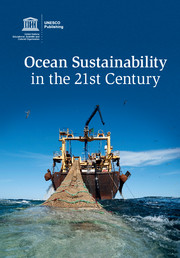Book contents
- Frontmatter
- Contents
- List of contributors
- Acronyms and abbreviations
- Foreword by Irina Bokova, Director-General of UNESCO
- Foreword by Thomas E. Lovejoy
- Preface
- Acknowledgements
- 1 Issues regarding oceans and opportunities: an introduction to the book
- 2 Main human uses of ocean areas and resources, impacts, and multiple scales of governance
- 3 Physical and chemical changes in the ocean over basin-wide zones and decadal or longer time-scales: perspectives on current and future conditions
- 4 Knowledge and implications of global change in the oceans for biology, ecology, and ecosystem services
- 5 A new perspective on changing Arctic marine ecosystems: panarchy adaptive cycles in pan-Arctic spatial and temporal scales
- 6 Ecosystem approach and ocean management
- 7 Challenges in using valuation in ecosystem-based management in a marine context: the case of UK Marine Protected Area designation
- 8 The contribution of international scientific cooperation and related institutions to effective governance for the oceans: the cases of regional tsunami early warning systems and the Argo project
- 9 Emerging and unresolved issues: the example of marine genetic resources of areas beyond national jurisdiction
- 10 The assumption that the United Nations Convention on the Law of the Sea is the legal framework for all activities taking place in the sea
- 11 The legal regime of outer space in light of the Law of the Sea
- 12 Towards sustainable oceans in the 21st century
- Index
- References
11 - The legal regime of outer space in light of the Law of the Sea
Published online by Cambridge University Press: 05 May 2015
- Frontmatter
- Contents
- List of contributors
- Acronyms and abbreviations
- Foreword by Irina Bokova, Director-General of UNESCO
- Foreword by Thomas E. Lovejoy
- Preface
- Acknowledgements
- 1 Issues regarding oceans and opportunities: an introduction to the book
- 2 Main human uses of ocean areas and resources, impacts, and multiple scales of governance
- 3 Physical and chemical changes in the ocean over basin-wide zones and decadal or longer time-scales: perspectives on current and future conditions
- 4 Knowledge and implications of global change in the oceans for biology, ecology, and ecosystem services
- 5 A new perspective on changing Arctic marine ecosystems: panarchy adaptive cycles in pan-Arctic spatial and temporal scales
- 6 Ecosystem approach and ocean management
- 7 Challenges in using valuation in ecosystem-based management in a marine context: the case of UK Marine Protected Area designation
- 8 The contribution of international scientific cooperation and related institutions to effective governance for the oceans: the cases of regional tsunami early warning systems and the Argo project
- 9 Emerging and unresolved issues: the example of marine genetic resources of areas beyond national jurisdiction
- 10 The assumption that the United Nations Convention on the Law of the Sea is the legal framework for all activities taking place in the sea
- 11 The legal regime of outer space in light of the Law of the Sea
- 12 Towards sustainable oceans in the 21st century
- Index
- References
Summary
11.1 Space law at its inception and analogy with other regimes
Outer space is an area encompassed among spaces beyond the limits of national jurisdiction and for this reason its legal regime is often associated with those applicable to other common spaces, such as the high seas and the deep seabed, and to Antarctica. The legal regime concerning outer space, the Moon, and the other celestial bodies does not draw inspiration from a specific part of international law; rather it deals with a mixture of multiple analogies (Peterson, 1997; DeSaussure, 1992; Kopal, 1992).
During the 1980s, space law was frequently defined as a special branch of international law. However, this definition cannot be considered more than a ratione materiae criterion, since space law was born in the context of international law, and its applicability to space activities has been confirmed by all of the relevant United Nations general treaties and declarations. Currently, it is commonly also presumed to cover domestic laws and the laws of the European Union concerning space activities. Therefore, space law can be defined as a ‘specific and coherent set of rules applicable to activities of states and other subjects, including private subjects, in outer space or related to outer space activities’ (Marchisio, 2006).
The inception of space activities marks the beginning of space law. On 13 December 1958, the General Assembly of the United Nations set up an Ad Hoc Committee as its subsidiary body, with the aim to deal with space matters. Between 1959 and 1962, the Committee for Peaceful Uses of Outer Space (Ad Hoc Committee for Peaceful Uses, then COPUOS) released three important resolutions: Resolution 1472 (XIV) (12 December 1959) and Resolution 1721 (XVI) (20 December 1961), both concerning international cooperation in the peaceful uses of outer space; and Resolution 1962 (XVIII) (13 December, 1963) concerning the legal principles governing the activities of states in the exploration and uses of outer space. Although not binding, these resolutions reflected the opinion of a relevant number of states on basic principles of space law in statu nascendi.
- Type
- Chapter
- Information
- Ocean Sustainability in the 21st Century , pp. 249 - 274Publisher: Cambridge University PressPrint publication year: 2015



